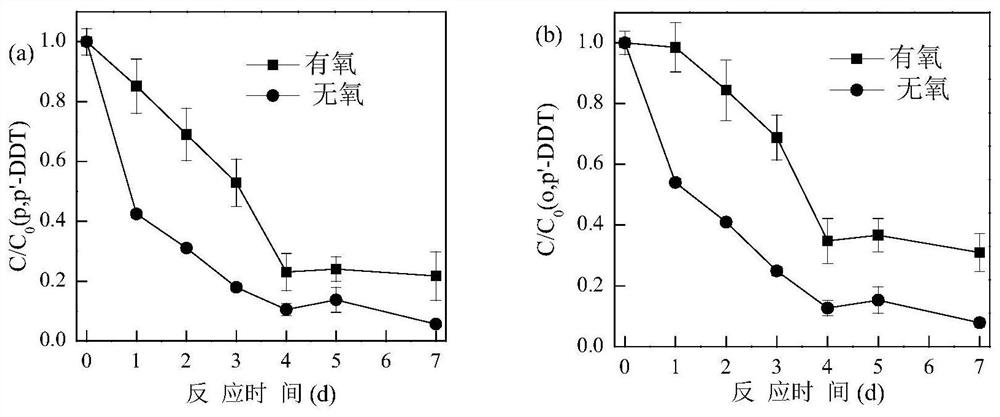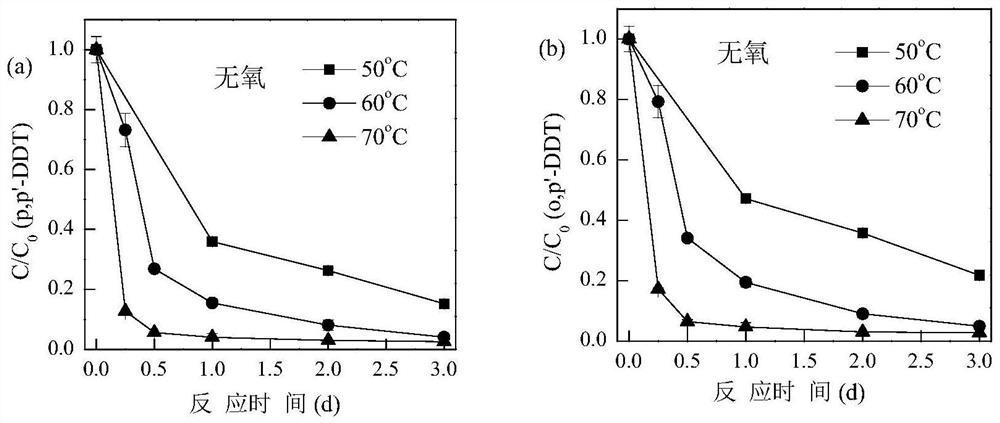A kind of composition and application thereof for processing ddt in polluted soil
A technology of polluted soil and composition, applied in the field of soil remediation, can solve problems such as organochlorine pesticide DDT pollution, and achieve the effects of fast production speed, stable production rate, and economical efficiency
- Summary
- Abstract
- Description
- Claims
- Application Information
AI Technical Summary
Problems solved by technology
Method used
Image
Examples
Embodiment 1
[0028] The solid-to-liquid ratio was 1:10 (g / mL), the PS concentration was 0.1M, and the temperature was 50°C. The effects of initial aerobic and anaerobic conditions on DDT removal were compared.
[0029] A 9mL brown bottle with a polytetrafluoroethylene gasket on the cover was used as the reaction vessel, and 0.5g of contaminated soil was weighed into the reaction vessel, and the prepared PS solution was added, and water was added to make the concentration of PS 0.1M, and the volume of the solution was 5mL. The reaction bottle was placed in a reciprocating shaking box at 200 rpm, and reacted for 3 days. Initial anaerobic conditions: the aqueous solution was purged with nitrogen for 30 minutes, the PS solution was prepared with anaerobic water, and the reaction samples were prepared in an anaerobic glove box. Initial aerobic conditions: It is not necessary to blow the aqueous solution with nitrogen, and the reaction sample preparation is carried out in air.
[0030] The res...
Embodiment 2
[0032] The solid-to-liquid ratio was 1:10 (g / mL), the PS concentration was 0.1M, and the initial anaerobic condition was used to compare the effect of the temperature at 60-70°C on the removal of DDT.
[0033]A 9mL brown bottle with a Teflon gasket on the cover was used as the reaction vessel, and 0.5g of contaminated soil was weighed into the reaction vessel, and the prepared PS solution was added, and water was added so that the concentration of PS was 0.1M, and the volume of the solution was 5mL. The reaction bottle was placed in a reciprocating shaking box at 200rpm. The aqueous solution was purged with nitrogen for 30 minutes, the PS solution was prepared with anaerobic water, and the reaction samples were prepared in an anaerobic glove box.
[0034] The result is as figure 2 As shown, the reaction temperature is 60°C, and after 3 days of reaction, the degradation rates of p,p'-DDT and o,p'-DDT can reach 94% and 95%. The reaction temperature is 70°C, and after 0.5 day...
Embodiment 3
[0036] The solid-to-liquid ratio was 1:10 (g / mL), the PS concentration was 0.1M, the temperature was 50°C, and the initial anaerobic condition was used to compare the effect of PS on the removal effect of DDT at 0.2-0.5M.
[0037] Use a 9mL brown bottle with a Teflon gasket as the reaction vessel, weigh 0.5g of contaminated soil into the reaction vessel, add the prepared PS solution, and add water to make the concentration of PS 0.2 and 0.5M. The volume is 5 mL. The reaction bottle was placed in a reciprocating shaking box at 200rpm. The aqueous solution was purged with nitrogen for 30 minutes, the PS solution was prepared with anaerobic water, and the reaction samples were prepared in an anaerobic glove box.
[0038] The result is as image 3 It was shown that when the concentration of PS was 0.2M, the degradation rates of p,p'-DDT and o,p'-DDT could reach 89% and 85% after 3 days of reaction. The PS concentration was 0.5M, and after 3 days of reaction, the degradation rat...
PUM
 Login to View More
Login to View More Abstract
Description
Claims
Application Information
 Login to View More
Login to View More - Generate Ideas
- Intellectual Property
- Life Sciences
- Materials
- Tech Scout
- Unparalleled Data Quality
- Higher Quality Content
- 60% Fewer Hallucinations
Browse by: Latest US Patents, China's latest patents, Technical Efficacy Thesaurus, Application Domain, Technology Topic, Popular Technical Reports.
© 2025 PatSnap. All rights reserved.Legal|Privacy policy|Modern Slavery Act Transparency Statement|Sitemap|About US| Contact US: help@patsnap.com



